
.
Running Plays
.
|
|
|
|
|
|
|
|
|
|
|
|
|
|
|
|
|
|

|
|
|
|
|
|
|
|
|
|
|
|
|
|
|
|
|
|
|
|
|
|
|
|
|
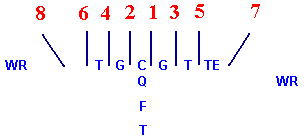 The
Running Lanes are numbered from the Center position to the side lines.
Each gap between offensive players is numbered with the odd numbers running
down the right side, the even numbers to the left. The 'Zero' hole
refers to a play designed to be run directly through the Center's position
such as a Zero Draw or the Quarterback Sneak. A running lane or hole
is simply a point of reference usually designating where a player or the
ball is to go. Note the highest numbers (7 & 8) refer to the
area outside the TE. If no TE is present, then a play run to the
left at lane #8 (in the diagram here) would specify a play intended to
be executed to the outside--NOT to the OT's outside shoulder which would
be lane #6. Generally speaking, a play is called with a two digit
number first. The first digit signifies the back to receive the ball,
the second digit refers to the hole or running lane the play is directed
at.
The
Running Lanes are numbered from the Center position to the side lines.
Each gap between offensive players is numbered with the odd numbers running
down the right side, the even numbers to the left. The 'Zero' hole
refers to a play designed to be run directly through the Center's position
such as a Zero Draw or the Quarterback Sneak. A running lane or hole
is simply a point of reference usually designating where a player or the
ball is to go. Note the highest numbers (7 & 8) refer to the
area outside the TE. If no TE is present, then a play run to the
left at lane #8 (in the diagram here) would specify a play intended to
be executed to the outside--NOT to the OT's outside shoulder which would
be lane #6. Generally speaking, a play is called with a two digit
number first. The first digit signifies the back to receive the ball,
the second digit refers to the hole or running lane the play is directed
at.
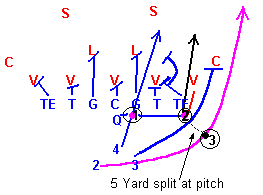
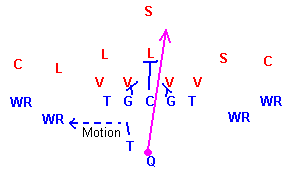 The
Quarterback
Draw is shown here run from the Double Slots Formation
with the shotgun, and with the up back sent in motion to the left.
The Quarterback takes the snap, pump fakes a quick pass, then tucks the
ball away securely and sprints through the zero running lane (up the middle).
In this diagram the defense is in a 4-3 set slightly modified due to the
presence of four wide receivers. If the defenders were in a five
man front (e.g.. using a nose guard) the Quarterback would "read" the Center's
block and break accordingly. This play can be run from absolutely
any formation and need not employ the shotgun nor motion by the up back.
In the QB Sneak the Quarterback would take the snap from under Center,
possibly signaling to the Center via touch which side of the Center the
QB was going to run.
The
Quarterback
Draw is shown here run from the Double Slots Formation
with the shotgun, and with the up back sent in motion to the left.
The Quarterback takes the snap, pump fakes a quick pass, then tucks the
ball away securely and sprints through the zero running lane (up the middle).
In this diagram the defense is in a 4-3 set slightly modified due to the
presence of four wide receivers. If the defenders were in a five
man front (e.g.. using a nose guard) the Quarterback would "read" the Center's
block and break accordingly. This play can be run from absolutely
any formation and need not employ the shotgun nor motion by the up back.
In the QB Sneak the Quarterback would take the snap from under Center,
possibly signaling to the Center via touch which side of the Center the
QB was going to run.
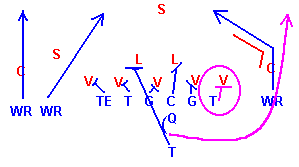 The
"10 Bootleg" is not really run to the "zero" lane, it is
an end around run by the Quarterback without proper blocking. All
other backs in the back field run away from the play attempting to pull
defensive pursuit the wrong way. Shown here from the Pro Formation
the QB fakes to the lone running back and sprints around end taking his
key from the Tackle, breaking appropriately dependent upon the Tackle's
block. This play can be run from any formation.
The
"10 Bootleg" is not really run to the "zero" lane, it is
an end around run by the Quarterback without proper blocking. All
other backs in the back field run away from the play attempting to pull
defensive pursuit the wrong way. Shown here from the Pro Formation
the QB fakes to the lone running back and sprints around end taking his
key from the Tackle, breaking appropriately dependent upon the Tackle's
block. This play can be run from any formation.
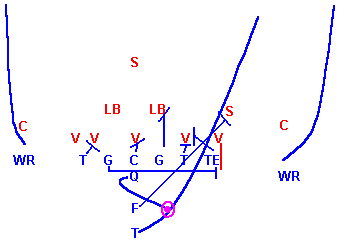 due
to the FB leading through the hole. If the off side Guard traps back
to the play (shown here) he blocks the DE. If the G does not pull,
the FB "kicks out" the DE. If a double team is not necessary the
TE can hit then release from the DE (scrape) and block down on the LB or
any other would be tackler in pursuit. Another option is to send
a wide out to the play side in motion to the play and block down on the
DE. Then the Guard (or FB) call lead around the end--as in the 27
Sweep. In the Sweep, the off side Tackle blocks for one count,
the releases to down field block. The QB opens to the off side to
delay pursuit. This play can be run from any 2-back formation with
at least one TE.
due
to the FB leading through the hole. If the off side Guard traps back
to the play (shown here) he blocks the DE. If the G does not pull,
the FB "kicks out" the DE. If a double team is not necessary the
TE can hit then release from the DE (scrape) and block down on the LB or
any other would be tackler in pursuit. Another option is to send
a wide out to the play side in motion to the play and block down on the
DE. Then the Guard (or FB) call lead around the end--as in the 27
Sweep. In the Sweep, the off side Tackle blocks for one count,
the releases to down field block. The QB opens to the off side to
delay pursuit. This play can be run from any 2-back formation with
at least one TE.
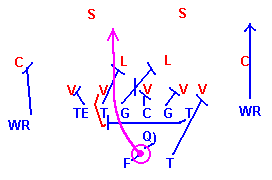 The
34 Trap is depicted here as run from the Veer Left Formation.
Technically the diagram shows the 34 Counter Trap since the Quarterback
and the Fullback both feint to the right like the Tailback, then counter
step to run back to the #4 hole. The left Guard first makes sure
the nose tackle is cut off, then scrapes to the Linebacker. This
play can be run from any formation featuring at least one back. The
FB could also "lead" the TB in a 24 Counter Lead and/or Trap. The
play can also be run without the counter steps, substituting the counter
with a count delay for the FB.
The
34 Trap is depicted here as run from the Veer Left Formation.
Technically the diagram shows the 34 Counter Trap since the Quarterback
and the Fullback both feint to the right like the Tailback, then counter
step to run back to the #4 hole. The left Guard first makes sure
the nose tackle is cut off, then scrapes to the Linebacker. This
play can be run from any formation featuring at least one back. The
FB could also "lead" the TB in a 24 Counter Lead and/or Trap. The
play can also be run without the counter steps, substituting the counter
with a count delay for the FB.
 from
any formation featuring at least one running back. Here the Quick
Pitch Left is shown run from the I Formation. The off side OT releases
without contact and flies to the flat hoping to throw a block using the
"eyes" rule of blocking (only hit a man if you can see his eyes).
Realistically, the only way an OT can get to the play is if the RB cuts
back inside, which he well may do. All off side personnel from the
OT to the side line block down field to create a cut back lane for the
RB.
from
any formation featuring at least one running back. Here the Quick
Pitch Left is shown run from the I Formation. The off side OT releases
without contact and flies to the flat hoping to throw a block using the
"eyes" rule of blocking (only hit a man if you can see his eyes).
Realistically, the only way an OT can get to the play is if the RB cuts
back inside, which he well may do. All off side personnel from the
OT to the side line block down field to create a cut back lane for the
RB.
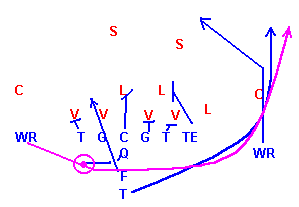 The
Reverse, also known as the End around, (shown here from the I Right
Formation) can be run to either side and from any formation. Even
a Tight End or Slot Man can run the reverse. The play side wide out
runs a post to at least temporarily occupy the Cornerback and a Safety.
In this diagram the Tailback acts as a lead blocker, but there need not
be one. In this case the right Wide Receiver can "hitch" and run
to the ball carrier to run the Double Reverse. As with most
runs around end, the ball carrier can pass the ball as well, as in a Halfback
Pass.
The
Reverse, also known as the End around, (shown here from the I Right
Formation) can be run to either side and from any formation. Even
a Tight End or Slot Man can run the reverse. The play side wide out
runs a post to at least temporarily occupy the Cornerback and a Safety.
In this diagram the Tailback acts as a lead blocker, but there need not
be one. In this case the right Wide Receiver can "hitch" and run
to the ball carrier to run the Double Reverse. As with most
runs around end, the ball carrier can pass the ball as well, as in a Halfback
Pass.
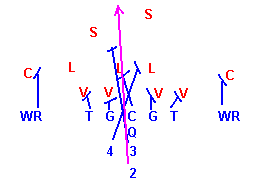 The
22 lead is illustrated here run from the Power I Left Formation
with the Tight Ends split wide. Both the #4 and the #3 backs lead
through the #2 running lane with the #2 back taking the direct hand off.
This play can be run from any formation with at least two running backs
and to any running lane. If run from a one back formation, the correct
name would be a "Blast 2." Since only one back is present in a one
back set, only the run type and assigned lane need be expressed.
The
22 lead is illustrated here run from the Power I Left Formation
with the Tight Ends split wide. Both the #4 and the #3 backs lead
through the #2 running lane with the #2 back taking the direct hand off.
This play can be run from any formation with at least two running backs
and to any running lane. If run from a one back formation, the correct
name would be a "Blast 2." Since only one back is present in a one
back set, only the run type and assigned lane need be expressed.
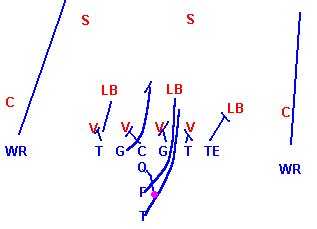 The
23 Lead is an inside power running play designed to take advantage of a
four man defensive alignment. Trap plays are more difficult to execute
in the tight confines inside the Tackles. Here a Lead or Blast play
is more effective. In the 23 Lead the Fullback 'leads' the Tailback
through the #3 hole. The Fullback's objective is to hit the first
man he sees--hopefully the Linebacker to the play side. In the diagram
shown here, the TE kicks out his man while the Center and off side Guard
utilize a technique called "cross blocking", further exposing the four
man defensive line. The off Guard's responsibility is to attempt
to cut off weak side pursuit. The off side Tackle blocks for one
count then releases down field for the same purpose.
The
23 Lead is an inside power running play designed to take advantage of a
four man defensive alignment. Trap plays are more difficult to execute
in the tight confines inside the Tackles. Here a Lead or Blast play
is more effective. In the 23 Lead the Fullback 'leads' the Tailback
through the #3 hole. The Fullback's objective is to hit the first
man he sees--hopefully the Linebacker to the play side. In the diagram
shown here, the TE kicks out his man while the Center and off side Guard
utilize a technique called "cross blocking", further exposing the four
man defensive line. The off Guard's responsibility is to attempt
to cut off weak side pursuit. The off side Tackle blocks for one
count then releases down field for the same purpose.
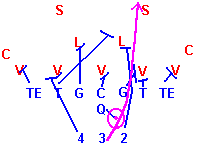 The
33 lead is a basic lead play only the Fullback is the ball
carrier with the Tailback lead blocking. The play is illustrated
here as run from the Full House Formation but can be run from any formation,
although to be classified as a lead play there will need to be two backs.
The off side Tackle and the lead back both try to block the play side Linebacker.
The
33 lead is a basic lead play only the Fullback is the ball
carrier with the Tailback lead blocking. The play is illustrated
here as run from the Full House Formation but can be run from any formation,
although to be classified as a lead play there will need to be two backs.
The off side Tackle and the lead back both try to block the play side Linebacker.
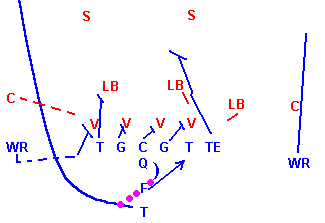 The
Counter Pitch is a misdirection play intended to take advantage of single
coverage on the lone wide out to one side. Shown here the left WR
comes down the line of scrimmage in motion. The snap is timed so the WR
can "crack down" on the defensive end. The intention is for the DB
responsible for covering the WR to come inside in motion with the WR. This,
combined with the play opening to the strong (TE) side and the linemen
blocking down hopefully sets the defense in motion to the TE side.
After an initial false step to the strong side, the Tailback reverses and
sprints to the weak side receiving the quick pitch from the QB. The
strong side Tackle and TE down field block. The play seeks to take
advantage of the fact that the DB is coming inside and will have to reverse
his direction to make the play. Another variation is for the WR to
lead block the DB rather than going in motion, or even to continue in motion
past the play.
The
Counter Pitch is a misdirection play intended to take advantage of single
coverage on the lone wide out to one side. Shown here the left WR
comes down the line of scrimmage in motion. The snap is timed so the WR
can "crack down" on the defensive end. The intention is for the DB
responsible for covering the WR to come inside in motion with the WR. This,
combined with the play opening to the strong (TE) side and the linemen
blocking down hopefully sets the defense in motion to the TE side.
After an initial false step to the strong side, the Tailback reverses and
sprints to the weak side receiving the quick pitch from the QB. The
strong side Tackle and TE down field block. The play seeks to take
advantage of the fact that the DB is coming inside and will have to reverse
his direction to make the play. Another variation is for the WR to
lead block the DB rather than going in motion, or even to continue in motion
past the play.
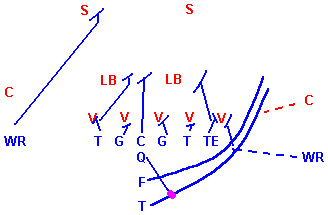 The
27 Sweep is a power sweep play similar to the 27 Lead. In the example
shown here the 27 Sweep is run with the WR in motion cracking down on the
containment man. The FB then blocks the DB trailing the WR, or the
first man that shows. The TE blocks for one count then 'scrapes'
up field to cut off defensive pursuit. All Linemen left (off side)
of the Center do likewise. Another variation would involve splitting
the back field in a Veer formation (FB to the TE side), or TB to the TE
side and handing the ball to the FB as in the 37 Sweep. The off side
WR can be replaced by an additional FB (3 backs) and run with both FB's
leading through the hole as in a 27 Blast.
The
27 Sweep is a power sweep play similar to the 27 Lead. In the example
shown here the 27 Sweep is run with the WR in motion cracking down on the
containment man. The FB then blocks the DB trailing the WR, or the
first man that shows. The TE blocks for one count then 'scrapes'
up field to cut off defensive pursuit. All Linemen left (off side)
of the Center do likewise. Another variation would involve splitting
the back field in a Veer formation (FB to the TE side), or TB to the TE
side and handing the ball to the FB as in the 37 Sweep. The off side
WR can be replaced by an additional FB (3 backs) and run with both FB's
leading through the hole as in a 27 Blast.
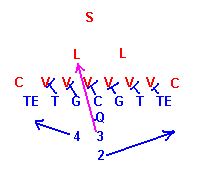 The
32 Blast is shown here run from the Double Tight Power I
Formation. The defense is depicted as being in a 6-4 (short yardage)
formation. No mismatch is represented in the diagram. In fact,
the defense is in an ideal gap defense to stop the play for minimal gain.
If the play is to be run unmodified for the defensive set, the only procedure
available for the offensive line is for the entire line to block down.
A much wiser option for the Quarterback would be to turn to the #4 back
and yell the audible "Lead!" This would tell the #4 back to lead
block through the running lane. An audible changing the entire play
is also an option in this instance.
The
32 Blast is shown here run from the Double Tight Power I
Formation. The defense is depicted as being in a 6-4 (short yardage)
formation. No mismatch is represented in the diagram. In fact,
the defense is in an ideal gap defense to stop the play for minimal gain.
If the play is to be run unmodified for the defensive set, the only procedure
available for the offensive line is for the entire line to block down.
A much wiser option for the Quarterback would be to turn to the #4 back
and yell the audible "Lead!" This would tell the #4 back to lead
block through the running lane. An audible changing the entire play
is also an option in this instance.
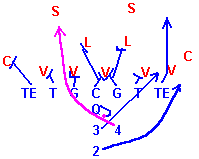 The
44 Blast is shown here run from Power I Right Formation.
The fact that there are two Fullbacks designates this play is intended
to be run from a four back formation. As in most Blast plays, there
is no lead blocker. The Tailback and other Fullback, as well as the
Quarterback, start to the non play side. The ball carrier receives
the hand off and runs to the appropriate hole. Add a counter step
by the ball carrier and the play becomes the 44
Counter Blast. If the Tailback (#2 back) leads through the
lane the play becomes another version of the 44 Lead.
The
44 Blast is shown here run from Power I Right Formation.
The fact that there are two Fullbacks designates this play is intended
to be run from a four back formation. As in most Blast plays, there
is no lead blocker. The Tailback and other Fullback, as well as the
Quarterback, start to the non play side. The ball carrier receives
the hand off and runs to the appropriate hole. Add a counter step
by the ball carrier and the play becomes the 44
Counter Blast. If the Tailback (#2 back) leads through the
lane the play becomes another version of the 44 Lead.
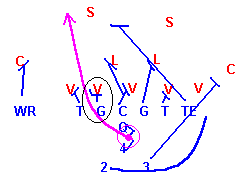 The
44 Counter Blast is similar to the 44 Blast. The ball
carrier simply adds a counter step in an attempt to momentarily freeze
the Linebackers.
The
44 Counter Blast is similar to the 44 Blast. The ball
carrier simply adds a counter step in an attempt to momentarily freeze
the Linebackers.